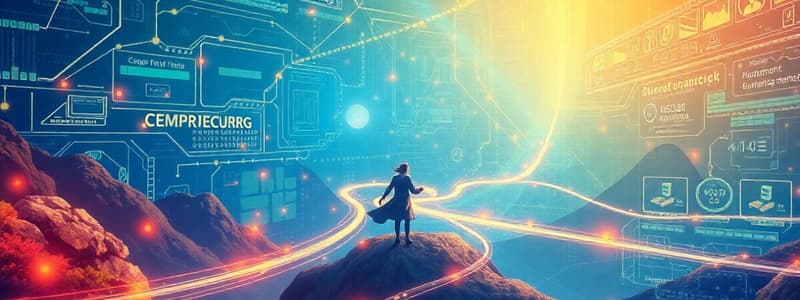Podcast
Questions and Answers
Le système d'information (SI) est un ensemble cohérent de ressources permettant de :
Le système d'information (SI) est un ensemble cohérent de ressources permettant de :
- Créer de la valeur ajoutée.
- Gérer les interactions avec les clients.
- Collecter, traiter, stocker, diffuser et protéger les informations nécessaires au fonctionnement d'une organisation. (correct)
- Aligner la technologie sur les objectifs de l'entreprise.
Quelles sont les cinq fonctions fondamentales du SI ?
Quelles sont les cinq fonctions fondamentales du SI ?
- Collecter, Traiter, Stocker, Analyser, Protéger
- Collecter, Traiter, Stocker, Diffuser, Analyser
- Capturer, Traiter, Stocker, Analyser, Protéger
- Collecter, Traiter, Stocker, Diffuser, Protéger (correct)
Lequel de ces éléments N'EST PAS une composante d'un SI ?
Lequel de ces éléments N'EST PAS une composante d'un SI ?
- Ressources humaines (correct)
- Infrastructure
- Processus métier
- Utilisateurs
- Applications
Un système d'information bancaire moderne est généralement organisé en zones fonctionnelles.
Un système d'information bancaire moderne est généralement organisé en zones fonctionnelles.
Qu'est-ce que l'urbanisation des SI ?
Qu'est-ce que l'urbanisation des SI ?
Quels sont les avantages des micro-services par rapport aux applications monolithiques ?
Quels sont les avantages des micro-services par rapport aux applications monolithiques ?
L'IA (Intelligence Artificielle) et le Machine Learning sont considérés comme des innovations technologiques importantes pour les systèmes d'information en 2024.
L'IA (Intelligence Artificielle) et le Machine Learning sont considérés comme des innovations technologiques importantes pour les systèmes d'information en 2024.
Lequel de ces éléments N'EST PAS un enjeu des systèmes d'information en 2024 ?
Lequel de ces éléments N'EST PAS un enjeu des systèmes d'information en 2024 ?
Expliquez brièvement la différence entre le front office, le middle office et le back office dans un contexte bancaire.
Expliquez brièvement la différence entre le front office, le middle office et le back office dans un contexte bancaire.
Flashcards
Système d'information (SI)
Système d'information (SI)
Un ensemble cohérent de ressources qui permettent de collecter, traiter, stocker, diffuser et protéger les informations nécessaires au fonctionnement d'une organisation.
Collecter (fonction du SI)
Collecter (fonction du SI)
Capacité du SI à saisir des données provenant de différentes sources, par exemple des capteurs, des utilisateurs ou des systèmes externes.
Traiter (fonction du SI)
Traiter (fonction du SI)
Transformation des données brutes en informations exploitables pour la prise de décision.
Stocker (fonction du SI)
Stocker (fonction du SI)
Signup and view all the flashcards
Diffuser (fonction du SI)
Diffuser (fonction du SI)
Signup and view all the flashcards
Protéger (fonction du SI)
Protéger (fonction du SI)
Signup and view all the flashcards
Clients (composant du SI)
Clients (composant du SI)
Signup and view all the flashcards
Employés (composant du SI)
Employés (composant du SI)
Signup and view all the flashcards
Partenaires (composant du SI)
Partenaires (composant du SI)
Signup and view all the flashcards
Processus métier (composant du SI)
Processus métier (composant du SI)
Signup and view all the flashcards
ERP (Enterprise Resource Planning)
ERP (Enterprise Resource Planning)
Signup and view all the flashcards
CRM (Customer Relationship Management)
CRM (Customer Relationship Management)
Signup and view all the flashcards
Applications spécifiques (composant du SI)
Applications spécifiques (composant du SI)
Signup and view all the flashcards
Référentiels (composant du SI)
Référentiels (composant du SI)
Signup and view all the flashcards
Transactions (composant du SI)
Transactions (composant du SI)
Signup and view all the flashcards
Documents (composant du SI)
Documents (composant du SI)
Signup and view all the flashcards
Infrastructure (composant du SI)
Infrastructure (composant du SI)
Signup and view all the flashcards
Transformation des données (valeur business du SI)
Transformation des données (valeur business du SI)
Signup and view all the flashcards
Soutien à la prise de décision (valeur business du SI)
Soutien à la prise de décision (valeur business du SI)
Signup and view all the flashcards
Personnalisation client (exemple d'application du SI)
Personnalisation client (exemple d'application du SI)
Signup and view all the flashcards
Maintenance prédictive (exemple d'application du SI)
Maintenance prédictive (exemple d'application du SI)
Signup and view all the flashcards
Gestion des stocks (exemple d'application du SI)
Gestion des stocks (exemple d'application du SI)
Signup and view all the flashcards
Front office (architecture d'un SI bancaire)
Front office (architecture d'un SI bancaire)
Signup and view all the flashcards
Middle office (architecture d'un SI bancaire)
Middle office (architecture d'un SI bancaire)
Signup and view all the flashcards
Back office (architecture d'un SI bancaire)
Back office (architecture d'un SI bancaire)
Signup and view all the flashcards
Flux d'information (SI moderne)
Flux d'information (SI moderne)
Signup and view all the flashcards
Sources de données (flux d'information)
Sources de données (flux d'information)
Signup and view all the flashcards
Traitement des données en temps réel (flux d'information)
Traitement des données en temps réel (flux d'information)
Signup and view all the flashcards
Traitement batch (flux d'information)
Traitement batch (flux d'information)
Signup and view all the flashcards
Stockage (flux d'information)
Stockage (flux d'information)
Signup and view all the flashcards
Utilisation des données (flux d'information)
Utilisation des données (flux d'information)
Signup and view all the flashcards
Study Notes
Introduction to Information Systems (IS)
- An information system (IS) is a structured set of resources used to collect, process, store, distribute, and protect information needed for organizational operations.
- IS is a key strategic tool to align technology with business goals.
- Fundamental IS functions include: collecting data, processing data into information, storing information securely, disseminating information, and protecting data.
Components of an Information System (IS)
- IS comprises interconnected components:
- Users: Including clients (final consumers), employees (internal users), and partners (external collaborators).
- Business Processes: Examples include sales, production, and customer support.
- Applications: Like Enterprise Resource Planning (ERP) for managing resources, Customer Relationship Management (CRM) for optimizing client interactions, and specific applications for unique business needs.
- Data: Refers to the factual information, including references and operational transactions, and various documents.
- Infrastructure: Consists of physical and software components like servers, networks, security measures, and cloud platforms.
Value of IS
- IS provides measurable value to organizations beyond its technical aspects.
Modern Banking Systems Architecture
- Modern banking systems are organised into functional areas:
- Front Office: Customer interaction via web, mobile, and physical branches.
- Middle Office: Internal processes like accounting, risk management, and treasury.
- Back Office: Core data processing, transactions, and reporting.
Information Flows in Modern IS
- Data flows follow a pattern:
- Data Sources: Originating from various sources (customers, IoT devices, partners).
- Data Processing: Real-time or batch processing techniques.
- Data Storage: Uses various solutions like transactional databases, data lakes, data warehouses.
- Data Usage: Information used for dashboards, analytics, business intelligence tools.
Information System (IS) Challenges in 2024
- Digital Transformation: Adoption of cloud infrastructure and APIs (Application Programming Interfaces)
- Technological Innovation: Integration of Artificial Intelligence (AI), Edge Computing, and environmentally sustainable IT.
- Cybersecurity: Protecting against ever-increasing online threats.
- Financial Optimization (FinOps): Precise cost management and return on investment (ROI) of IT investments
IS Modernization (Urbanization) Methodology
- A structured approach to modernize information systems:
- As-Is Mapping: Assessment of current state.
- Analysis: Identification of weaknesses and opportunities.
- To-Be Architecture: Design of the future system architecture, standards, and directions.
- Implementation Plan: Migration plan with budgeting, scheduling, and prioritization.
Evolution of Software Architecture
- Monolithic Applications: Single integrated application.
- Layered Applications: Separates functionalities (presentation, business logic, data access).
- Microservices: Independently deployable and manageable services.
Studying That Suits You
Use AI to generate personalized quizzes and flashcards to suit your learning preferences.



